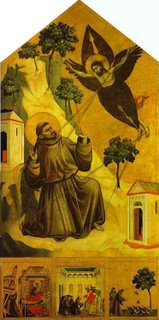
The next four stanza's, #s 25-28, ask and answer a question: why did the Nun call out? What is the truth of her cry? "The majesty! what did she mean?" It's all beautifully, artfully constructed: after asking what the Hun meant, Hopkins over three stanzas offers potential answers only to dismiss them, at least dismiss them as not being each alone enough of an answer.
This is a series which begins with "Breathe, arch and orginal Breath," which is an invocation of the Muse of the Holy Spirit--rather like the opening of Milton's Paradise Lost which develops the imagery from the opening of Genesis whre the Spirit of God hovered over the waters------a series which begins with the Holy Spirit and ends with an image of the waters as a Dragon, which of course reminds us of the drama of the Apocalypse as well as the Babylonian creation-myth of Marduk slaying Tiamut or Jehovah slaying Leviathin, underlying the original Genesis account as well. These stanzas, obviously, run the full sweep of God's affair with the world, from Creation to Apocalypse, particularly climaxing in:
"Other, I gather, in measure her mind's
Burden, in wind's burly and beat of endragoned seas."
Other than what? Hopkins implies that een his crazy words fail to fully explain the Nun's call. Options? Love. The Crown. The Total Mystery. Or, as Leonore and Floristan sing in Fidelio:
"O namenlose Freude!" or "O Joy With No Name!"--a set of statements that defy logic, senses, and words:
"What by your measure is the heaven of desire,
The treasure never eyesight got, nor was everguessed what for the hearing?"
Hopkins, in stanza #26, asks this question of Nature, of Day and Night, and the Stars. Silence, I presume is the answer. And the Nun was not motivated by quiet, pious spirituality: Hopkins wittily compares the Nun to the effete spirituality, perhaps, of gentlemanly-kept Jesuit fathers "asking for ease fo the sodden-with-its-sorrowing heart" in #27, while the Hun faces a real threat--"danger, electrical horror." He even dryly referes perhaps to his own piety:
"...then further it finds
The appealing of the Passion is tenderer in prayer apart:
Other, I gather, in measure her mind's
Burden..."
Once again, Hopkins is comparing, juxtaposing himself-at-prayer and the Nun-at-sea. And once again, it must be emphasized, this juxtaposition gives the whole poem's two contrasting parts a unity--the first part on the spiritual conversion of Hopkins, the second part about the Nun in the wreck.
Now in stanza #28, he offers an answer to the question--an answer which is not an answer in words but rather in words a re-creation of an experience, at the very crux of the Cross, at the intersection of all the overlapping lines of this poem's several tales--the Paschal Mystery. Hopkins does not state this: he re-creates the experience by drawing us, quite self-consciously, into the composition of the poem:
"But how shall I . . . make me room there:
Reach me a . . . Fancy, come faster--
Strike you the sight of it? look at it loom there,
Thing that she . . .There then! the Master,
Ipse, the only one, Christ, King, Head:
He was to care the extremity where he had cast her;
Do, deal lort it with living and dead;
Let him ride, her pride, in his triumph, dispatch and have done with his doom there."
This 28th stanza--blunt in their erotic imagery--in its brevity of 8 lines, truncates and concentrates the "First Principle and Foundation" of the first part's 10 stanzas. And what does Hopkins call the object of the Nun's call? Thing. Thing? Thing! Ipse! She encounters, really, the real Thing. Christ. No wonder Hopkins is so amazingly erotic, exciting, even hot. He is describing an experience that surpasses even appealing tenderness or "electrical horror!" He is describing the real encounter with Jesus Christ. And that is what the Nun is calling out!
The majesty! what did she mean?
Breathe, arch and original Breath.
Is it love in her of the being as her lover had been?
Breathe, body of lovely Death.
They were else-minded then, altogether, the men
Woke thee with a we are perishing in the weather of Gennesareth.
Or is it that she cried for the crown then,
The keener to come at the comfort for feeling the combating keen?
For how to the heart’s cheering
The down-dugged ground-hugged grey
Hovers off, the jay-blue heavens appearing
Of pied and peeled May!
Blue-beating and hoary-glow height; or night, still higher,
With belled fire and the moth-soft Milky Way,
What by your measure is the heaven of desire,
The treasure never eyesight got, nor was ever guessed what for the hearing?
No, but it was not these.
The jading and jar of the cart,
Time’s tasking, it is fathers that asking for ease
Of the sodden-with-its-sorrowing heart,
Not danger, electrical horror; then further it finds
The appealing of the Passion is tenderer in prayer apart:
Other, I gather, in measure her mind’s
Burden, in wind’s burly and beat of endragonèd seas.
But how shall I … make me room there:
Reach me a … Fancy, come faster—
Strike you the sight of it? look at it loom there,
Thing that she … there then! the Master,
Ipse, the only one, Christ, King, Head:
He was to cure the extremity where he had cast her;
Do, deal, lord it with living and dead;
Let him ride, her pride, in his triumph, despatch and have done with his doom there.
.jpg)





 So now Hopkins gives us a long meditation on that Tall Nun, from stanza 19 through stanza 31. This is very much the climax of The Wreck of the Deutschland.
So now Hopkins gives us a long meditation on that Tall Nun, from stanza 19 through stanza 31. This is very much the climax of The Wreck of the Deutschland.